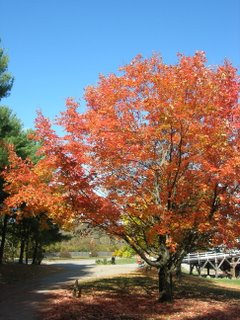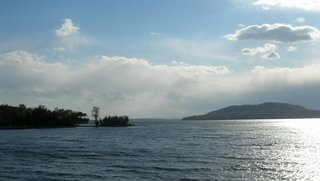
Fall foliage is big business in New England. The roads are full of tour buses and cars with out of state plates, the hotels are booked in advance as I found out when I tried to get a room in one where the parking lot was empty, and tiny towns with church steeples rising above orange trees are packed with visitors. "How's the color?" and "Has it peaked yet?" can be heard on every side. The leaf peepers are in season.
The dominant color is orange, and even where pine trees keep the forest green you can find a speck of orange in the ubiquitous pumpkin. They're everywhere, in the fields,
 on house porches and in stores, along with what appear to be scarecrows. New Englanders like to make fall tableaus to illustrate the season not unlike the Christmas creches on lawns in December. They also decorate their houses with ghosts and bats and cobwebs. Halloween is a major event in this region where everything will soon shut down after the snow season begins.
on house porches and in stores, along with what appear to be scarecrows. New Englanders like to make fall tableaus to illustrate the season not unlike the Christmas creches on lawns in December. They also decorate their houses with ghosts and bats and cobwebs. Halloween is a major event in this region where everything will soon shut down after the snow season begins.Not everyone likes the leaves. My friend Jim in Bristol, VT, surveyed the acre of lawn and trees in his backyard and calculated the work it would take to remove the fallen and soon-to-fall leaves before snow covered the ground. Leaves kill grass and so would have to go. He tried mulching them with his ride-on lawn mower but was displeased with the effect. So we raked up several piles and filed the bed of his truck with them. The next morning we desposited the leaves at the nearby city dump. It seemed like an endless job, an illustration of eternity.
In southern New Hampshire, the fall foliage color has been spoiled by a leaf blight affecting mostly Norway maple trees. Instead of turning red, the leaves fade to
 yellow with an ugly black spot in the middle. In the north, up near Burlington, Vermont, the leaves in places have peaked, leaving hillsides of bare branches waiting for their covering of snow. I passed numerous ski resorts, still deserted, and at Mad River there was a sign saying "Pray for Snow." In some regions through which I traveled, fields of pine trees held the green in place, punctuating the splashes of deciduous oranges and reds. Looking for the perfect photograph is dangerous business. I kept my Nikon at the ready on the seat beside me and frequently pulled over to the side of the road when I spied a fabulous vista. But all too often I found the view obscured by wires and poles. Capturing this annual transformation is hard work.
yellow with an ugly black spot in the middle. In the north, up near Burlington, Vermont, the leaves in places have peaked, leaving hillsides of bare branches waiting for their covering of snow. I passed numerous ski resorts, still deserted, and at Mad River there was a sign saying "Pray for Snow." In some regions through which I traveled, fields of pine trees held the green in place, punctuating the splashes of deciduous oranges and reds. Looking for the perfect photograph is dangerous business. I kept my Nikon at the ready on the seat beside me and frequently pulled over to the side of the road when I spied a fabulous vista. But all too often I found the view obscured by wires and poles. Capturing this annual transformation is hard work.Yes, I've joined the tribe of leaf peepers. A number of us, mostly white-haired, stood in the lobby at Ben & Jerry's ice cream factory in Waterbury as we waited for the tour to begin (every ten minutes). You can't look at leaves all of the time. And Ben & Jerry's is an icon for baby boomers who now have the leisure time to look for their roots. The lobby was filled with self promotion and sourvenirs. Two Jewish nerds from New York come to Vermont in the 1970s and make such good ice cream that it goes global. And they do it by promoting social and political causes with every pint. They name their first unique blend after Jerry Garcia. Could anything be more cool?
But Ben & Jerry sold out. "They've gone to do their own thing," the tour guide told us, over free samples of apple pie ice cream, complete with bits of apple and pie crust embedded in the vanilla. What isn't mentioned in the literature is that B&J is part of the Unilever family of products, which includes Best Foods mayonnaise, Coleman's mustard, Lipton tea, Dove soap and Pepsodent dental products. It is the world's largest manufacturer of ice cream under a variety of different brand names. How can you be socially conscious when you're an integral part of global capitalism's reign of terror?
Besides Cherry Garcia, my favorite flavor these days is Phish. I didn't buy a tie-dyed tee shirt, however.

For my last day in Vermont, Jim and Linda took me to Shelburne Museum south of Burlington which features over 40 acres of exhibits in a multitude of facilities including a fully-restored Lake Champlain steam ship, the Ticonderoga, now in drydock on the landscaped grounds. Many of the antiques and folk arts on display were assembled by the eccentric collector, Electra Webb. I saw old toys and a variety of weather vanes. A docent explained the the history of the Ticonderoga and how it operated, and another made objects in a blacksmith shop that had been moved piece by piece to the grounds of the museum. There was also a visiting exhibition of paintings by Georgia O'Keefe that was attracting the biggest crowds.
On the way back to Bristol, we stopped in Charlotte and took a brief trip on a Lake Champlain ferry to visit New York state across the lake. This was the shortest and most southerly ferry route, but it operates all year round. The passenger compartment contained photos of a ferry navigating through ice to keep the states connected. As we neared the village of Essex, now mostly closed for winter, dark clouds headed eastward from the Adirondacks. Rain was on the way.


1 comment:
What to say! Your photos are great! And as usual you words are a joy to read. Don't stop.
It's remarkable to realize the beauty of different parts of our country. t
Post a Comment